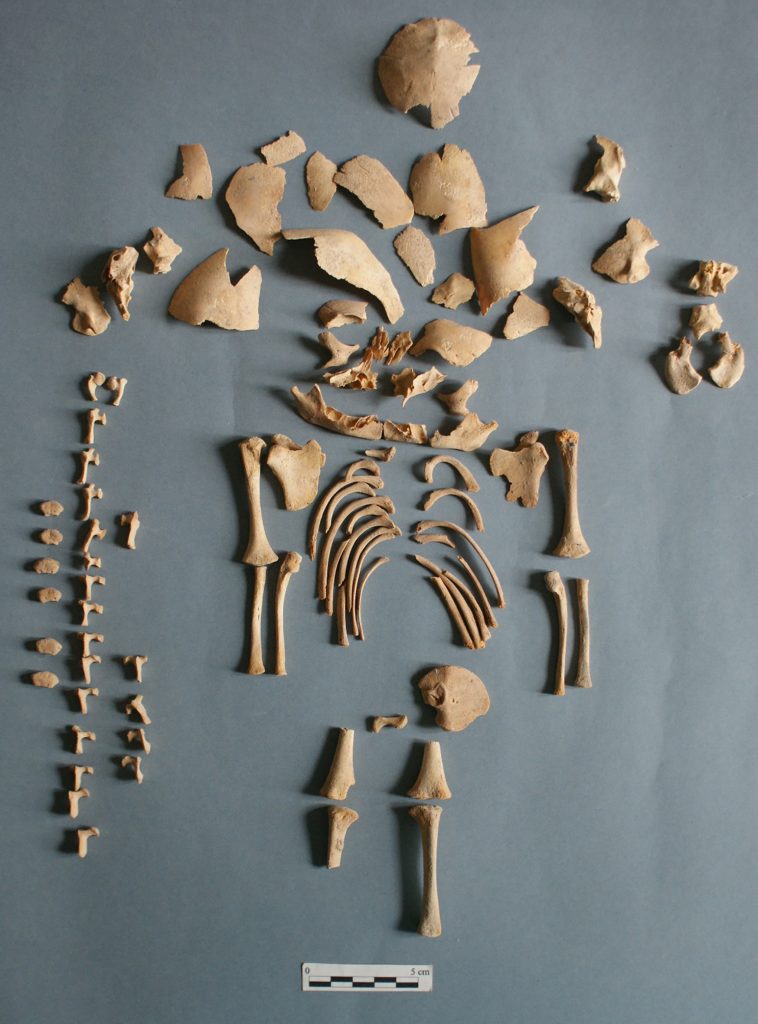
A groundbreaking study analyzing ancient DNA has revealed instances of Down and Edwards syndrome in prehistoric human remains, dating back as far as 4,500 years. This research indicates that individuals with these conditions were valued and integrated members of their ancient societies, offering new insights into the treatment and recognition of chromosomal disorders in history. Above are the remains of individual “CRU001”, who the researchers discovered had Down syndrome. The remains were found at a site in Spain dating to the Iron Age. Credit: Photograph from the Government of Navarre and J.L. Larrion.
By analyzing ancient DNA, an international team of researchers has uncovered cases of chromosomal disorders, including what could be the first case of Edwards syndrome ever identified from prehistoric remains.
The team identified six cases of Down syndrome and one case of Edwards syndrome in human populations that were living in Spain, Bulgaria, Finland, and Greece from as long ago as 4,500 years before today.
Discovery of Chromosomal Disorders
The research indicated that these individuals were buried with care, and often with special grave goods, showing that they were appreciated as members of their ancient societies.
The global collaborative study, led by first author Dr Adam “Ben” Rohrlach of the University of Adelaide, and senior author Dr Kay Prüfer of the Max Planck Institute for Evolutionary Anthropology, involved screening DNA from approximately 10,000 ancient and pre-modern humans for evidence of autosomal trisomies, a condition where people carry an extra (third) copy of one of the first 22 chromosomes.
Methodology and Findings
“Using a new statistical model, we screened the DNA extracted from human remains from the Mesolithic, Neolithic, Bronze, and Iron Ages all the way up to the mid-1800s. We identified six cases of Down syndrome,” says Dr Rohrlach, a statistician from the University of Adelaide’s School of Mathematical Sciences.
“While we expected that people with Down syndrome certainly existed in the past, this is the first time we’ve been able to reliably detect cases in ancient remains, as they can’t be confidently diagnosed by looking at the skeletal remains alone.”
Down syndrome occurs when an individual carries an extra copy of chromosome 21. The researchers were able to find these six cases using a novel Bayesian approach to accurately and efficiently screen tens of thousands of ancient DNA samples.
“The statistical model identifies when an individual has approximately 50 percent too much DNA that comes from one specific chromosome,” says Dr Patxuka de-Miguel-Ibáñez of the University of Alicante, and lead osteologist for the Spanish sites.
“We then compared the remains of the individuals with Down syndrome for common skeletal abnormalities such as irregular bone growth, or porosity of the skull bones, which may help to identify future cases of Down syndrome when ancient DNA can’t be recovered.”
Additional Discoveries and Cultural Insights
The study also uncovered one case of Edwards syndrome, a rare condition caused by three copies of chromosome 18, that comes with far more severe symptoms than Down syndrome. The remains indicated severe abnormalities in bone growth and an age of death of approximately 40 weeks gestation.
All of the cases were detected in perinatal or infant burials, but from different cultures and time periods.
“These individuals were buried according to either the standard practices of their time or were in some way treated specially. This indicates that they were acknowledged as members of their community and were not treated differently in death,” says Dr Rohrlach.
“Interestingly, we discovered the only case of Edwards syndrome, and a noticeable increase in cases of Down syndrome, in individuals from the Early Iron Age in Spain. The remains could not confirm that these babies survived to birth, but they were among the infants buried within homes at the settlement, or within other important buildings,” says Professor Roberto Risch, co-author and archaeologist from The Autonomous University of Barcelona.
“We don’t know why this happened, as most people were cremated during this time, but it appears as if they were purposefully choosing these infants for special burials.”
Reference: “Cases of trisomy 21 and trisomy 18 among historic and prehistoric individuals discovered from ancient DNA” by Adam Benjamin Rohrlach, Maïté Rivollat, Patxuka de-Miguel-Ibáñez, Ulla Moilanen, Anne-Mari Liira, João C. Teixeira, Xavier Roca-Rada, Javier Armendáriz-Martija, Kamen Boyadzhiev, Yavor Boyadzhiev, Bastien Llamas, Anthi Tiliakou, Angela Mötsch, Jonathan Tuke, Eleni-Anna Prevedorou, Naya Polychronakou-Sgouritsa, Jane Buikstra, Päivi Onkamo, Philipp W. Stockhammer, Henrike O. Heyne, Johannes R. Lemke, Roberto Risch, Stephan Schiffels, Johannes Krause, Wolfgang Haak and Kay Prüfer, 20 February 2024, Nature Communications.
DOI: 10.1038/s41467-024-45438-1
The research was part of a large collaborative project involving researchers from the University of Adelaide, including Dr. Adam “Ben” Rohrlach, Dr. Jonathan Tuke, and Associate Professor Bastien Llamas, as well as researchers from across the world, including at the Max Planck Institute for Evolutionary Anthropology in Germany where the data was generated.
>>> Read full article>>>
Copyright for syndicated content belongs to the linked Source : SciTechDaily – https://scitechdaily.com/ancient-dna-reveals-first-known-case-of-edwards-syndrome-in-prehistoric-humans/










